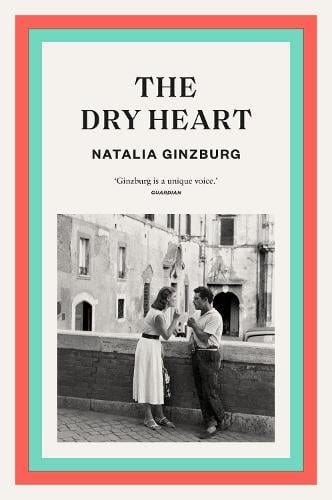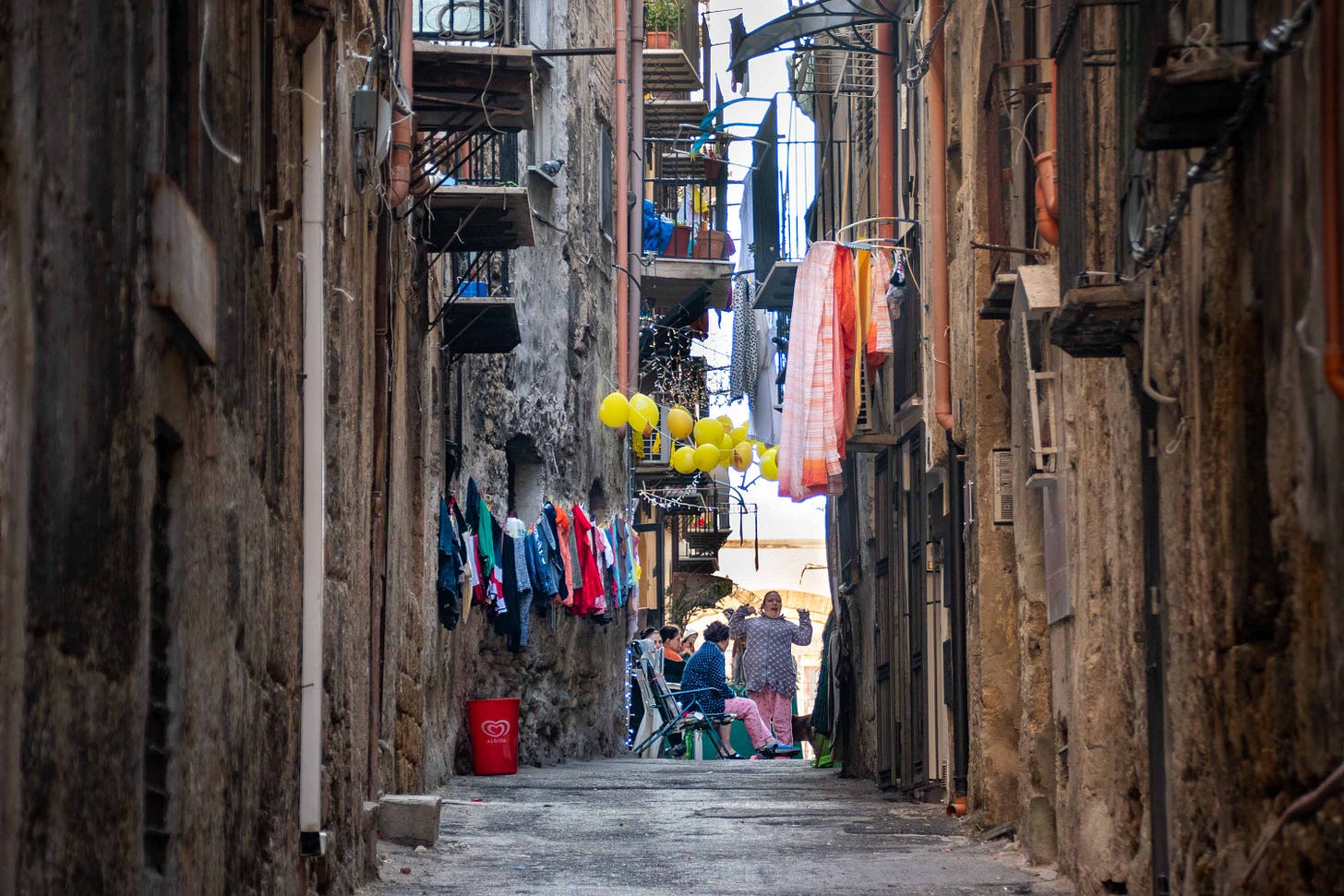Welcome to A Narrative of Their Own, where I discuss the work of 20th century women writers and their relevance to contemporary culture.
If you enjoy reading essays on literature as well as monthly reviews of great books and recommended reading, please consider a free or paid subscription.
I came to this author after a luxurious bookshop browse a few Saturday’s ago, discovering a whole shelf of her novels. I then got a recommendation for one of her books in the comments section of my recent essay on the joy of the short novel from my reader pal Juliana and, never one to ignore serendipity when it stares you in the face, I decided I must read some of Ginzburg’s work immediately!
The Road to the City was my first introduction to her work which, having researched the writer, appears to have set out her distinctive writing style for the novels that followed.
In her debut, written when Ginzburg was living in hiding in the Abruzzo region in 1941, she tells the story of Delia, a young adolescent girl. The book was initially published under the pseudonym of Alessandra Tornimparte as Mussolini’s Italy forbade books to be published by Jewish authors. In an afterword to the novel, Ginzburg stated that she found the writing of the novel difficult, lacking in confidence, and worried that she may not be able to meet the sufficient writing length of the genre, having previously written short stories.
Ginzburg claims she was feeling nostalgic for her native city of Turin where she spent most of her youth whilst writing the book, and this helped her to develop the very real characters that populate it.
There is a real intimacy within her narrative and dialogue. The story is narrated by Delia, a young girl living in a small provincial country location which boasts a single road which leads to the city of the title.
Bored with her provincial country life, Delia longs to escape and live in the city like her older sister Azalea, and so walks there and back every day in order to feel a part of city life. The road provides an ideal metaphor for the journey Delia undergoes in the short novel from adolescent innocence into adulthood.
Meeting the local doctor’s son Giulio, she thinks she wishes to marry him and allow him to aid her escape to the city, as her sister has done through marriage. Later, finding herself pregnant to Giulio, he eventually agrees to marry her once his studies are over, due to pressure from both Delia and his own parents.
Delia doesn’t love Giulio, and experiences brief indicators of what love might look like from her distant cousin Nini, who, after the loss of his mother as a boy, was taken in by the family. Delia comes from a large family of children, with her mother a brow-beaten and unhappy woman and her father silent and often absent.
The time she spends with Nini is often her happiest, swimming as they did as children and sitting on the riverbank, talking. Nini is a reader and appears intellectual, but needing to work to pay his way in the city, he has taken a manual job in a factory. He is sensitive; a thinker who has aspirations for a more meaningful life. Falling in love with Delia, he leaves her with the choice of whether to face her feelings for him, or marry Giulio, with the promise of a more prosperous life in the city.
The story is uncomplicated in its structure, but hides many deeper meanings below the surface.
The lives and limited choices of women, particularly when limited by socioeconomic barriers, are brought sharply into focus, as well as the frustrations and loneliness engendered by such barriers. The hard and thankless work of the housewife and the discrepancies in gender choices are also a factor. The women around Delia sometimes push against these restraints, such as older sister Azalea, who has escaped her rural existence by marrying an older man and having a family of her own. But she then spends her days pining after lovers and ignoring her children. She tells Delia:
“You must always do as you please with men because if you act like a weakling, they’ll take away the very air you breathe.”
I loved the style of Ginzburg’s spare prose which provides for a simple understanding of the issues facing Delia and the mental processes of her thinking. There is a general feeling of unease and tension throughout the text.
My copy of the book also contains the novella, The Dry Heart.
In this short text, Ginzburg chooses to open with a view to the ending: a woman who has just shot her husband. An intriguing plot line to begin the story with. The rest of the novella then explores what led up to this in retrospect.
‘Tell me the truth,’ I said.
‘What truth?’ he echoed. He was making a rapid sketch in his notebook and now he showed me what it was: a long, long train with a big cloud of black smoke swirling over it and himself leaning out of the window to wave a handkerchief.
I shot him between the eyes.
In slightly over a hundred pages, Ginzburg’s unnamed narrator takes us back to her first meeting of husband Alberto, their walks, their marriage, and how it all fell apart. This reflection takes place over four years.
First published in 1940, the narrative appears to be told by a female narrator who has a fairly casual attitude to the murder she has committed. However, it quickly unravels, and we realise that the narrator is neither level-headed nor a cold-blooded killer. Suffering along in a difficult marriage, Ginzburg cleverly explores not who committed the murder- we know that from the outset- but what led to it. Shooting her husband and then retreating to a café to drink coffee and relate her story, we get to come along with her and decide why she might have committed such a crime.
We discover that her husband could not stop himself from visiting his long-time lover. His wife, meanwhile, much younger than him (this seems to be a bit of a theme in Ginzburg’s work) has come to the city from a rural background and feels lonely. Her older husband is used to the city and enjoys introducing it to her. She feels that she is falling in love with Alberto, though he does not initially show any affection towards her. He confesses that he, too, is lonely after losing his mother and agrees to marry her, taking her to live in his mother’s house.
They have a child, a daughter, and Alberto becomes more separate from their lives. We then discover that their daughter died at the age of two, and though Alberto comforts his wife, he picks up with his older lover, Giovanna. When his wife asks him to tell her the truth, she feels he is still evading her, and shoots him between the eyes. The story has brought us back to the beginning and the end.
The story is essentially about a marriage that should never have happened, similar to The Road to the City, and it felt to me as though the unnamed narrator could easily have been Delia and Guilio four years’ on.
Again, it is a tale of loneliness of both parties, despite being in a marriage, and I think it really showcases how Ginzburg was an expert at using the short form to tell a larger story.
Natalia Ginzburg was born Natalia Levi in Palermo, Sicily, in 1916, becoming a published author at eighteen years of age when the Florentine periodical Solaria published her first novella, I Bandini. She became the first person to translate Marcel Proust’s Du côté de chez Swann into Italian.
Her first novel The Road to the City was published in Italian in 1942, and in 1963, Ginzburg won the Strega Prize for her own humorous autobiographical work, Lessico Famigliare (Family Sayings), which dealt with her family’s anti-fascist life in Turin.
She became politically active in the 1980s, joining the Communist Party and being elected to Parliament as an independent left-wing deputy in 1983 and 1987.
Growing up, Ginzburg’s father Giuseppe Levi was a domineering figure in her life, both inspiring an air of guilt and fear into her, and a kind of hero-worship admiration and wish to emulate him.
In 1919, Giuseppe was appointed professor at the University of Turin, leading Ginzburg to grow up in a cultural, anti-fascist milieu, with her parental home becoming a meeting place for intellectuals. Ginzburg’s non-Jewish mother, Lidia Tanzi, was the daughter of a socialist lawyer and the family also boasted other prominent members from the arts and science world. But their anti-fascist, anti-monarchist, and atheist leanings led to the family being excluded from the mainstream, leading Ginzburg to study at home with her mother rather than attending primary school. In 1927, Ginzburg did attend the Vittorio Alfieri high school, going on to begin her university studies in literature, specialising in Classics, in 1935, though she never completed her studies.
In 1938, Ginzburg married editor and political activist Leone Ginzburg, a Russian Jew from Odessa who headed Turin’s clandestine anti-fascist movement, Giustizia e Liberta. Ginzburg’s three brothers and father were also members. Leone was a scholar in Slavic studies, and lectured on Russian literature at Turin University as well as working for the Einaudi publishing house.
In 1940, when Leone was interned in Pizzoli, a village in the Abruzzo region, Ginzburg followed him with their two small sons, later giving birth to a daughter there in 1943.
Einaudi published The Road to the City the same year, and the family moved to Turin, then later, Rome. Participating in underground resistance to the fascist regime, Leone was arrested and transferred to prison, where he was tortured and killed in 1944. His wife was unable to visit him throughout his internment.
Ginzburg moved with her children to Florence following her husband’s death, later returning to Rome following the liberation. She worked as an editor for her publisher, Einaudi, and lived at the old home of her parents, which she loved. The publishing house was responsible for introducing such writers as Elsa Morante and Italo Calvino, however Ginzburg rejected Primo Levi’s first book on his Holocaust experience, If This Is a Man, in 1947.
Ginzburg later remarried, and following the publication of All Our Yesterdays in 1952, she experienced the most prolific of her writing years, producing three of her major works.
Moving to London in 1959 where her second husband, Gabriele Baldini, was to head up the Italian Cultural Centre, she went on to win the Strega Prize for Lessico Famigliare. It is now a mandatory reading text in Italian schools.
In the 1980s, her political activism, animated by a profound sense of injustice, led her to engage in various humanitarian issues, including the lowering of the price of bread, support for Palestinian children, legal assistance for rape victims, and reform of adoption laws. Politics were not a comfortable fit for her however, and she soon resigned from the Communist Party.
Ginzburg, who often wrote stories about strong women, was an incredibly strong woman herself. Not only suffering the loss of her first husband through his torture and death in prison and raising her young children alone, but also having borne two further children with disabilities with her second husband, her son dying at the age of one, whilst her daughter being cared for by Ginzburg until the writer’s death in 1991.
Her publishing house released a posthumous book It’s Hard to Talk about Yourself in 1999, a text based on a series of radio talks in which Natalia Ginzburg spoke about her life and her literary work.
Arguably the most important woman writer of post-World War II Italy, Ginzburg died in Rome in 1991 at the age of seventy-five. Her books do not sugarcoat the realities of family life and the female experience, whilst retaining an air of the humour, strength, and doggedness of their creator.
If you’re new around here, I usually write about all things women literature related. My paid subscribers also receive a monthly review of great books and recommended reading. Please consider a free or paid subscription - your support helps keep this newsletter afloat!








Great deep Ginzburg dive! I've added all her novels to our Wedding list. So far I've loved Valentino and Family Lexicon. https://substack.com/@readingseasonally/p-164148060
"The story is uncomplicated in its structure, but hides many deeper meanings below the surface." This, to be, is what brings me back and back again to Ginzburg and her peers! I'm so glad you got to know Ginzburg and I feel honored to be even mentioned in a post about! such a wonderful writer!
Did you know one of her sons, Carlo Ginzburg, is a historian famous for his exploration of microhistory—a way of thinking about great historical questions through small places and stories? Maybe, in a way, it runs in the family!